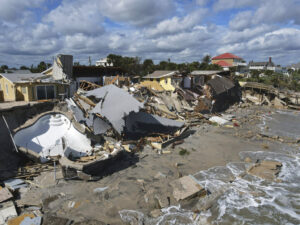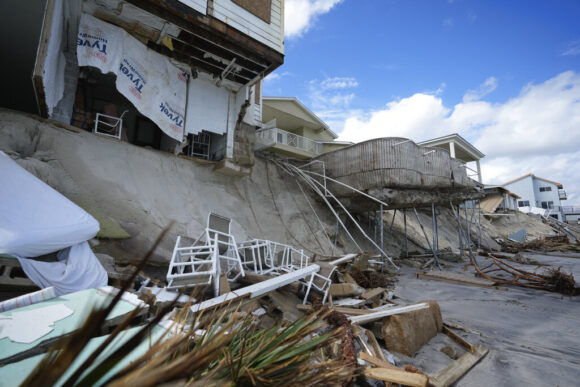Insured losses from Hurricane Nicole, a category 1 storm that came ashore on Florida’s east coast last week, will be no more than $750 million, a fraction of the level of losses caused by Hurricane Ian six weeks earlier, CoreLogic predicted, based on its computer models.
The property analytics firm has said Ian, which made landfall north of Fort Myers on Florida’s southwest coast Sept. 28, could reach as much as $51 billion in insured losses. Other estimates have put the total as high as $60 billion. CoreLogic’s model for Nicole includes losses from winds and storm surge, but not increased costs due to assignment-of-benefits agreements, the company said.
Many in the Florida insurance industry had feared that Nicole would be a staggering blow for some carriers, coming so soon after Ian and in the midst of a besieged property insurance market. But news reports from across the state’s eastern flank indicate that most of the damage was from storm surge at beach areas, not from the storm’s 75-mph winds.
“We anticipate insured property losses will be minimal from Hurricane Nicole. It was primarily a flood/storm surge event, with minimal windstorm damage and should not significantly impact Florida residential insurers,” said Mark Friedlander, director of communications for the Insurance Information Institute. “Hopefully, storm victims were financially protected with flood insurance from either the National Flood Insurance Program or private flood insurers.”
The eye of Nicole passed directly over Vero Beach, where longtime insurance agent and consultant David Thompson lives.
“I’ve been through a lot of hurricanes, but I’ve never had the eye come right over us,” he said.

Thompson’s home did not lose power and sustained no damage, though. “We are very fortunate,” he said.
To the north, agents and news outlets reported more damage, including some beachfront homes that partially collapsed into the sea.
At Wilbur-by-the-Sea, south of Daytona Beach, workers tried to stabilize remaining sections of land with rocks and dirt. It was too late for some, though: The front of one house laid on the sand, where it was sheared away from the rest of the structure.
Parts of otherwise intact buildings hung over cliffs of sand carved by pounding waves that covered the normally wide beach. Dozens of hotel and condominium towers as tall as 22 stories were declared uninhabitable in Daytona Beach Shores and New Smyrna Beach after seawater undercut their foundations. Just six weeks ago, Hurricane Ian caused an initial round of damage – which contributed to the problems from Nicole.
Retired health care worker Cindy Tyler, who lived in a seven-story condominium tower that was closed because of the storm, had a hard time coping with the idea of never being able to return to her building.
“I think right now I’m just in a state of hanging in there,” said Tyler, who was forced to evacuate with her husband and a few belongings. “I’m not believing I’m not going to be able to get back into my place. I’m trying to be very hopeful and very optimistic.”
Tenants in Tyler’s building spent $240,000 replacing a protective barrier that was battered by Ian, but the new fortification was no match for Nicole.
“Temporary seawall? Mother Nature said, `Hold my beer,”’ she said.

Restoring Daytona Beach – famous for its drivable beach – and nearby coastlines will likely require a major, multimillion-dollar sand renourishment project and improved sea walls to protect property, said Stephen Leatherman, director of the Laboratory for Coastal Research at Florida International University.
“It was known worldwide for driving on the beach,” said Leatherman, known as “Dr. Beach” for his annual ranking of U.S. beaches. “They don’t even have a beach to think about right now.”
One 15-mile stretch of the coast was severely eroded, with multiple seawalls destroyed. Much of the destruction was blamed on unrepaired seawalls bashed during Ian, which killed more than 130 people and destroying thousands of homes.
Volusia County officials said it wasn’t clear when people might be able to sunbathe next to their cars and pickup trucks on the beaches again.
“Assessments have begun and will be ongoing as we have 47 miles of beach,” county spokesman David Hunt said.
Five deaths resulted from Nicole, the first November hurricane in Florida in four decades. Fewer than 15,000 homes and businesses were without power across Florida by late Friday afternoon, down from a high of more than 330,000. No major disruptions were reported up the Eastern Seaboard, according to a tracking website.
As Nicole’s leftovers pushed northward, forecasters issued multiple tornado warnings in the Carolinas and Virginia, although no touchdowns were reported immediately. In south Georgia, Keith Post tried to clean up the damage at a coastal submarine museum that was submerged by floodwaters.
“At one point it was up to my knees,” said Post, whose St. Marys Submarine Museum sits on the river that forms the Georgia-Florida line at the Atlantic coast. “From the front of the museum looking across to Florida, you did not see any green. It was all water.”
Downgraded to a depression, Nicole was expected to dump as much as 8 inches of rain over the Blue Ridge Mountains, forecasters said, and there was a chance of flash and urban flooding as far north as New England.
Auto accidents added to Atlanta’s notoriously bad traffic as rain from Nicole fell across the metro area during rush hour, and a few school systems in mountainous north Georgia canceled classes.
Top photo: Beachfront homes damaged after the beach was eroded away by Hurricane Nicole’s waves in Wilbur-By-The-Sea, Florida. (AP Photo/Rebecca Blackwell)
Topics Florida Profit Loss
Was this article valuable?
Here are more articles you may enjoy.



 USAA to Lay Off 220 Employees
USAA to Lay Off 220 Employees  Soaring Insurance Costs Hit as US Buyers Finally Get a Break on Car Prices
Soaring Insurance Costs Hit as US Buyers Finally Get a Break on Car Prices  DeSantis Signs Bill Barring Local Worker Heat Protection Measures
DeSantis Signs Bill Barring Local Worker Heat Protection Measures  Undercover St. Louis Officer Beaten by Colleagues Awarded $23.5M
Undercover St. Louis Officer Beaten by Colleagues Awarded $23.5M 

